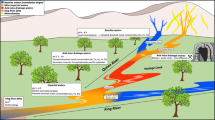Abstract
Sediments in the rivers and basins around Washington, DC, have high concentrations of phosphorus, which, based on geographic distributions, is largely derived from urban runoff and municipal sewage. Dissolved-particulate phosphate exchange reactions and biological uptake of dissolved phosphorus from the water column may be an added source of phosphorus to the sediments. Concentrations of total sedimentary phosphorus ranged from 24 to 56 μm P/g-dw, and were highest in areas near combined sewer outfalls. As a part of this study, sedimentary phosphorus was fractionated into Fe-P, Ca-P, Al-P, and organic phases using a selective-sequential leaching procedure. The distribution of the phases in all sediments analyzed follow the order , Fe-P>Ca-P>Al-P. Spatial variations in the amounts of phosphorus in the different phases is related to the sources of phosphorus to the area. The proportions of occluded Al-P and organic P are 10–20% of the total P, respectively. This suggests that phosphorus from natural sources is small compared to anthropogenic inputs in this area. The high leachable Fe-P and Ca-P in these sediments might contribute a substantial amount of P to the water column under conditions of remobilization.
Similar content being viewed by others
Author information
Authors and Affiliations
Additional information
Received: 20 February 1996 · Accepted: 2 April 1996
Rights and permissions
About this article
Cite this article
Huanxin, W., Presley, B. & Velinsky, D. Distribution and sources of phosphorus in tidal river sediments in the Washington, DC, Area. Environmental Geology 30, 224–230 (1997). https://doi.org/10.1007/s002540050150
Issue Date:
DOI: https://doi.org/10.1007/s002540050150




